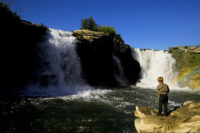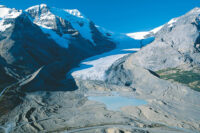Travel Alberta looking to jumpstart provincial tourism industry
By Al Beeber - Lethbridge Herald on March 10, 2022.
 Herald photo by Al Beeber
Travel Alberta CEO David Goldstein talks at an open house here Tuesday discussing the tourism industry in Alberta.
Herald photo by Al Beeber
Travel Alberta CEO David Goldstein talks at an open house here Tuesday discussing the tourism industry in Alberta.LETHBRIDGE HERALDabeeber@lethbridgeherald.com
With COVID-19 restrictions lifting, Travel Alberta is eager to get the provincial tourism industry back in high gear.
An open house in Lethbridge Tuesday hosted by Travel Alberta and the Tourism Industry Association of Alberta provided insights into the sector’s recovery and future growth.
Speakers included David Goldstein, chief executive officer of Travel Alberta and Darren Reeder, the board advisor of the tourism industry.
Both gave detailed talks about the provincial tourism industry and plans to get it restarted before they took questions from audience members at the Coast Hotel.
Before the pandemic, tourism generated $8.2 billion annually in Alberta supporting about 20,000 tourism related businesses and providing employment to 69,000 people.
Forecasts suggest recovery will take until 2024 before spending returns to 2019 levels.
Travel Alberta is making an effort to get that spending moving, one focus being to attract more American tourists to come to Alberta by air. A campaign has just opened with an engaging video presentation to be shown in California movie theatres. This program is also focused on Texas and New York, Goldstein told the audience.
A recent study by Destination Canada showed Alberta is consistently ranked highest in Canada in terms of tourist receptivity which gives the province an advantage in attracting visitors, Goldstein said.
“Albertans were happy to open their doors, and their homes and their communities to travellers even in the depths of COVID, which we believe gives us a very significant advantage,” he said.
The province’s three-year recovery plan has three stages, the first in 2021-22 being to retrench, the second in to 2022-23 to refresh and the third in 2023-24 to renew.
Marketing efforts are being aimed at what is considered “high value travellers,” those people who are likely to spend more money and more time while exploring more areas and being willing to travel in the off-season, said Goldstein.
Right now, Travel Alberta is focused on winter, primarily the ski business, he said. It’s also changing the “Remember to Breathe” slogan to “Adjust Your Altitude,” as it moves ahead post-COVID.
Investment in the Alberta travel industry is also going to help revitalize it with the province investing millions of dollars to support hundreds of projects.
“During COVID we weren’t really allowed to advertise tourism,” Goldstein said. While most of its budget went into supporting provincial organizations and individual businesses, Travel Alberta did have some marketing money and starting last summer, it was to reignite the spirit of Albertans and their sense of place, he said.
Pre-COVID, about half the $8.2 billion generated by tourism here came from Albertans travelling around the province, he said, adding that money is good for economic development in Alberta communities.
Another 25 per cent of revenue came from other Canadians travelling to Alberta, he said. The last 25 per cent was from International destinations, 65-70 per cent of those travellers being American.
“As you go up the scale, those will become increasingly more profitable segments of visitors,” Goldstein said of the foreign visitors.
“What we really want is fresh dollars to the Alberta economy and premium travellers who will spend more.”
During COVID, time was spent to get smarter about marketing. And while the province can’t outspend competitors, it has to outsmart them, he said.
“We’ve been very focused on who is the type of traveller we’re searching for,” Goldstein said.
Before COVID there were 1.5 billion travellers on the planet, and Destination Canada when Goldstein worked with that organization was trying to attract 20 million of those high-yield travellers.
“We as Alberta have to figure out what’s the two or three million of those we really want,” Goldstein said.
Those travellers are usually affluent and less susceptible to changes in economic circumstances, he added.
“These are the priority travellers that we’re trying to move to consider Alberta,” he said.
The primary market for the recovery right now is the U.S. and UK. Next year Germany will be added as a target and based on circumstances, Travel Alberta will look at reintegrating the Asian market.
Before COVID, Alberta “punched above its weight” in terms of U.S. travellers who come by air to the province. Because of COVID, the province lost 95 per cent of that traffic, Goldstein added.
“We’re the first provincial management marketing organization to have a dedicated air access support piece. We’re working directly with our carriers and in consultation with two major international airports. We will be looking in year two and three working with regional airports but right now the urgency is to rebuild those links to the two national airports,” added the CEO.
“The work that we’ve done and the work that our air carriers have done…have propelled Calgary into the third largest airport in the country,” he said.
“That’s important to us because there’s a lot of talk about pipelines in this province. Our pipeline has wings and the quicker we can build the air access” the stronger the tourism recovery will be, he said.
The province isn’t just interested in summer flights but frequency and extending the shoulder season, which have been difficult historically for Alberta, he said. About 45,000 more U.S. travellers were added in the business year that is finishing.
Travel Alberta has enhanced its $6 million co-op investment program for tourism businesses. That co-investment part was dropped during COVID and so the requirement was dropped for business to contribute.
This year, there won’t be a co-operative nature to the investment program, he added.
He said a partnership with Indigenous Tourism Alberta will be a $4 million agreement over three years, calling that an important tenet of the recovery plan.
Of a thousand applications for support, 200 were funded to the tune of $6.1 million, he said.
The business plan for the next year includes establishing travel corridors of itineraries within 2.5 to three-hour drives of an international airport. The two major cities and the Rockies account for about 65 per cent of tourism revenues in Alberta, Goldstein said, adding from the visitor’s perspective Travel Alberta wants to figure out what interesting things and interesting itineraries would take them from an international airport to other parts of the province.
An investment program of $2.5 million in grants will soon be launched with $100,000 being allotted for specific activities with details to be unveiled soon, he said.
Follow @albeebHerald on Twitter
4-3




